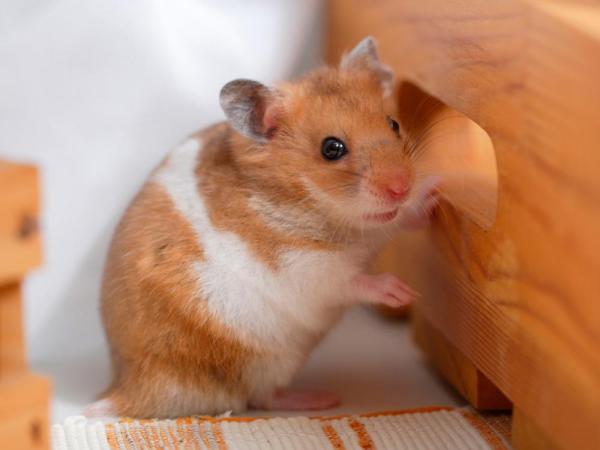Handling a small pet can be an enjoyable experience, but to safely keep hamsters, they must be tamed first.
With a few tried and proven steps, you can have your hamster in your hands in no time.
Before you begin training your hamster, there are a few easy guidelines to follow.
Hamsters are actually quite social animals who prefer spending time with their owners.
It is a terrific opportunity to socialize and play with your hamster, as well as a good way to check for any health issues.
But remember that your hamster may have never been touched before, so be patient before you jump right in.
Hamsters are very obedient pets who like being cuddled almost as much as their owners do.
Taming a hamster can usually be accomplished in a short period of time with regular, careful handling, but in order to ensure that your hamster has complete faith in you, there are a few steps you should take.
This will help alleviate stress and anxiety, as well as reduce the chance of biting.
If you follow these simple methods for taming your hamster, your nervous, furry ninja will transform into a loving, happy hamster in a matter of weeks (if not months).
Help Your Hamster Settle In
Consider your hamster’s perspective. Imagine being whisked away from the pet shop’s bright lights and familiar odors to a new cage with foreign eyes.
scary, right?
This is what your pet hamster experienced before you got it. So be patient and let them settle in, adjust, and explore.
As a family who recently tamed a pet, I know it’s hard to keep your hands from opening the cage for quick cuddling.
But remember the longer you let your hamster rest, the faster he’ll be tamed.
Give your hamster at least 2-3 days (if not longer) to adjust. Talk to them often so they come to know your voice, and make sure they’re comfortable eating, drinking, and playing in your company.
As tempting as these lovely furballs may be, it’s crucial that your hamster trusts you from the start.
Prepare Yourself and Your Hamster
Taming a hamster takes time and persistence. Don’t hurriedly complete each stage. Spend some time getting to know your hamster so you can react appropriately to its behavior.
In order for your hamster to realize that it has nothing to be afraid of you, you must first gain its trust.
Keep an eye out for signs that your hamster has adjusted to its surroundings. After it has hatched on its own, begin taming and training it.
As long as you are around, your hamster will eat, drink water, and play with other hamsters. For best results, spend more time near the cage and speak softly to your hamster.
Listening to a book being read aloud or softly singing can help when you don’t know what to say.
Offer Your Hamster Treats
A treat can be used to entice your hamster to come closer to you if they show signs of curiosity, such as approaching the bars.
Always wait until they are fully awake before approaching their nest or bedding area, as this violates their right to privacy.
It happened that our son tried to wake up our hamster by placing some food on his face while he was still in a deep sleep.
Both parties experienced the shock of their lives, so let’s just say it didn’t end well.
Start by giving them extra treats via the cage bars, and after they are comfortable with taking them from your fingers, you may calmly place your hand inside the cage and offer them more delicacies of the palm.
Maintaining a calm demeanor is essential if you want to keep your hands from frightening the animal.
If your hamster is reluctant at first, don’t worry; if you repeat the technique frequently and gradually, they will become accustomed to your scent.
Mixing up the snacks you serve is also a good idea because it encourages kids to try different meals, but if you pick something they are not interested in, they will be less likely to go out and explore new things.
Place some toilet paper that you’ve touched in your hamster’s cage so that they can nest in it as another technique to strengthen your bond with them.
To progress, your hamster must be comfortable hopping on and off your hand.
Hold Your Hamster
In order for your hamster to eat the treat, place it on your open palm inside the cage (and perhaps place a paw or two onto your hand to get the treat).
Let your hamster come to you, not the other way around. Make sure your hamster has to climb on you to get the treat if you try this next trick.
Gently and slowly scoop up your hamster once it’s done this (and only then). If you’re patient and persistent, your pet hamster is likely to learn that your hands are safe after the first few attempts.
A hamster’s age and personality influence how long it takes to complete each level. It may take a month or more for your hamster to get relaxed enough to tolerate being picked up or treats from your hand.
Let Your Hamster Move Around
When picking up a hamster, place one hand over its back and cup its palm.
Picking up your hamster should begin just above your lap or another soft surface to prevent it from falling or jumping.
Let your hamster crawl from one hand to the other and over your arms as it feels more comfortable.
The hamster may no longer be interested in treats if there are new sights and sounds to behold.
How to Play With Your Hamster?
It’s critical that you establish an area outside of the cage where you and your hamster may safely interact, play, and form a friendship.
In a huge box, a playpen, or even in the bath. You have my word that this is the only time my kids willingly jump in!
If your hamster decides to leap around, make sure the location is safe and comfortable for both of you.
Be patient and methodical in your approach to getting your hamster into an appropriate container or cup. Your hamster should be curious enough by this stage to jump right in.
Carrying them with care, bring them to your safe area of recreation.
Once they’re in the tub, let them explore you, sniff you, crawl all over you, and basically get to know you by themselves.
Bring along some tubes, hamster toys, and treats for them to play with.
Problems and Proofing Behavior
You may need to pick up an untamed hamster now and then to clean its cage, for example. It’s a simple matter of placing the cup on its side before the hamster, and then gently herding it into the cup (or tube).
The majority of hamsters are curious and will happily enter the cup. If the cup method hasn’t worked on a hamster that bites, use gloves or a large towel to protect your hands.
In order to avoid overwhelming your hamster and increasing its resistance to handling, avoid using this strategy if at all feasible.
Remember that your hamster didn’t try to hurt you if it bit you while you were handling it. All the hamster could sense was danger.
Avoid yelling or violently moving the hamster if you don’t have to.
Is it afraid of you if you do this?
Place the animal back in its cage and bathe its wounds with soap and water, calmly.
FAQs About Hamsters
How long does it take to tame a hamster?
There is nothing like a hamster. Some are eager to form a close relationship with you right away, while others may take weeks or even months to get used to you.
Syrian hamsters, in general, are more amenable to training than other hamster species, such as the Roborovski, which are smaller, timider, and more difficult to train.
Be patient, and you’ll get there.
Do hamsters enjoy being petted?
As solitary pets, Syrian hamsters thrive when they are regularly exposed to other people.
As a result, they will often snuggle or fall asleep while being held, and this is a sign of their gratitude.
It is common knowledge that most animals can detect their owners’ fragrances and will be at their happiest when spending time with their loved ones.
Why do hamsters bite?
Hamsters bite when they are scared, stressed, or anxious. Your hamster may nip you if you’ve never handled them before because they’re afraid of you.
They, too, require a good night’s rest and are apprehensive of being awakened or surprised.
It is also possible that your hamster will mistake your finger for an edible treat if you don’t wash your hands before interacting with it.
This relationship will be more fulfilling and less stressful for both of you as time goes on.






